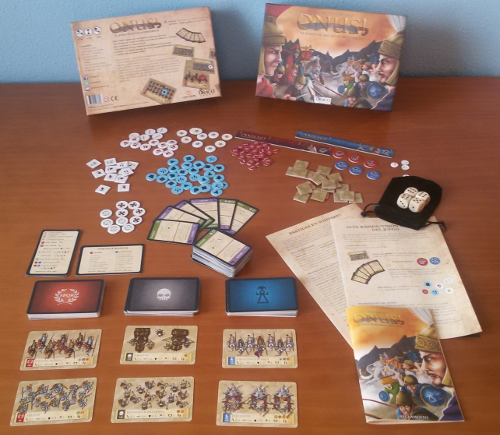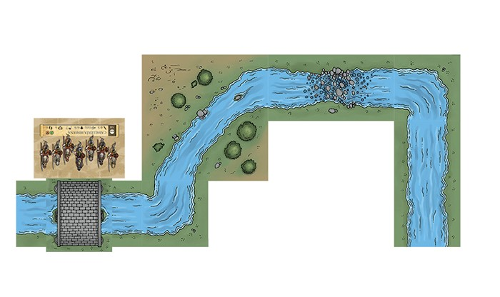ONUS! Rome vs Carthage Review
on May 16, 2017
The rather unfortunately titled Onus! Rome versus Carthage reminds me quite lot of a game that came out about ten years ago called Battleground: Fantasy Warfare. Both games are essentially rank-and-file wargames focused on set piece battles, but using cards with detailed united information printed directly on them rather than chits or miniatures. Indeed, Onus! is very much a historical miniatures wargame in spirit if not in material. But it is also quite a bit more detailed than something such as De Bellis Antiquitatis, featuring a quite intimidating set of rules that seem to account for every particular about ancients-era warfare you could possibly imagine. In that sense, another spiritual ancestor might be Richard Berg's Great Battles of History titles.
Make no mistake, Onus! is not for the casual player looking for a Memoir '44 style light wargame. This is relatively heavyweight stuff even though the cartoonish illustrations and promise of a "simplified" optional rules set might lead you to believe otherwise. It requires some digging in to get the most out of it, and despite some OK solo rules it also more or less demands that you have someone else close at hand that wants to hunker down with it. If you are in the market for a more serious Ancients wargame but are not interested in the hex-and-counter stuff (or Richard Berg's often interminable rules) and do not want to invest in miniatures or terrain then this could be an option. But be warned that it takes up almost as much table space as any other tabletop wargame.

Pictured: a full tabletop wargame. All of it.
Now, with the warnings out of the way, Onus! is overall a nice wargaming system that features highly detailed rules for flanking, changing formations, morale, leadership, ranged attacks, variances in unit types, encirclement, and terrain - especially if you have the Terrain and Fortresses expansion which brings with it quite a lot of additional rules. Many of the concepts are intuitive- pretty standard roll to hit/defense roll/roll to wound kinds of things that will be familiar to a Warhammer player for example- and it is great to have a unit's entire stats and abilities profile right there on the card that depicts that element of your army. So you always have a handle on what is going on with every unit in concert with some informational chits used for situational statuses.
The whole thing is card-driven, which is pretty interesting. You have a hand of cards (as determined by your army's leader) and play them to activate units in different combinations. OK, so maybe this part isn't too much different than Memoir '44. The cards also pull double duty, like many card-driven wargames, and provide narrative events. I especially like this element of the game. When you engage in melee or ranged combat, you pull a card off the deck and see if it is applicable based on the combat type. The event described affects the outcome in some way, either in favor of the attacker or defender. It's a fun and dramatic element that models uncertainty and fortune in the midst of battle.
You get quite a lot in the small box that Onus! comes in- two complete armies for the Romans and Carthaginians, of which you'll likely not use even half of the cards in even the larger games. A couple of suggested starter set ups are included, which I am glad for, if you do not care to build out your points-based armies. The rulebook, in its second edition translation from Spanish, is decent and you'll be thankful for it because you will reference it constantly. For the price, there really aren't any other games of this scope and depth out there and that is definitely a mark in its favor.

Terrain features like this river add a lot to the basic game...which is really not very basic at all.
There are a few expansions available for Onus! but I think the most significant and appealing one is the Terrain and Fortresses pack. This set, which is just as reasonably priced as the base game, adds a box full of 2D cardboard terrain pieces and some nifty clear plastic water elements with which to dress up the ol' green felt battlefield. As with any tabletop miniatures game, terrain makes everything more interesting with cover, bottlenecks, bog-downs and fortification now possible. The scenarios include sieges, attacks on villages, and various battles around key terrain features. The modular water pieces are great, allowing you to put a river down the middle between deployment zones or whatever you want to do. The downside is that the terrain types all add additional rules to a game already thick with them.
I'd say that anyone specifically interested in pursuing Onus! needs to start out with the Terrains and Fortresses pack from the start and incorporate those rules right from the get-go rather than to apply them later. This is very much an all-in kind of game, and to that end it is relatively demanded in an era when games are seemingly designed with a five play maximum lifespan. Is it worth the commitment? I don't know. For my part, I'm not sure that I want to throw myself into this game as there are other miniatures games I'd rather play but for those interested in a detailed, complex wargame in a small and inexpensive package Onus! could be hard to beat.

 Customer Support
Customer Support  Subscribe
Subscribe 




 Account
Account  Wishlist
Wishlist 

